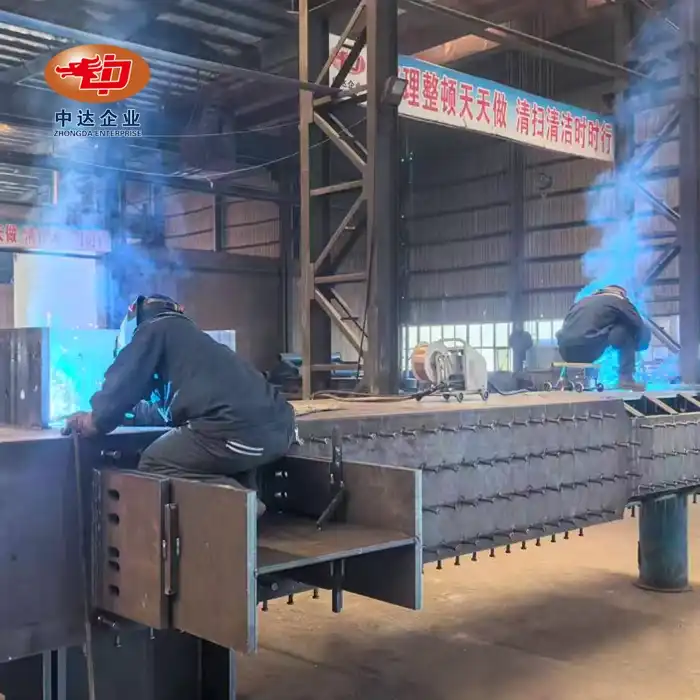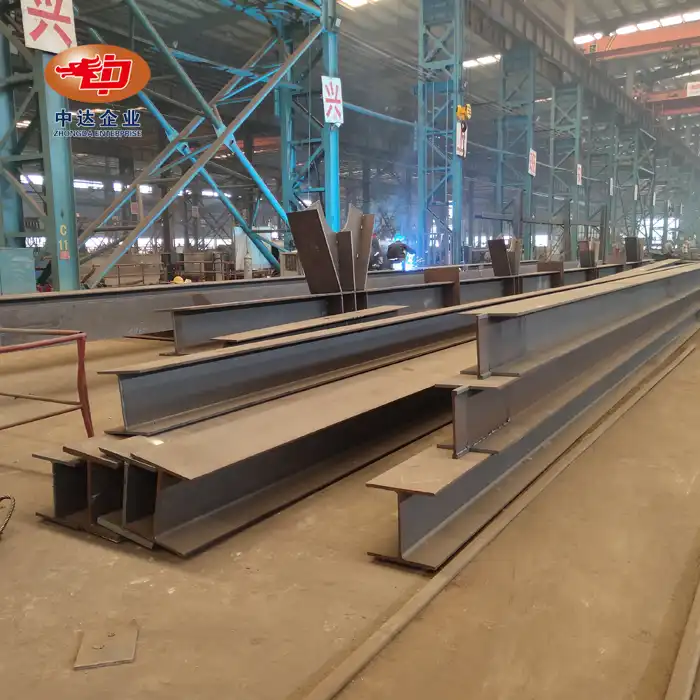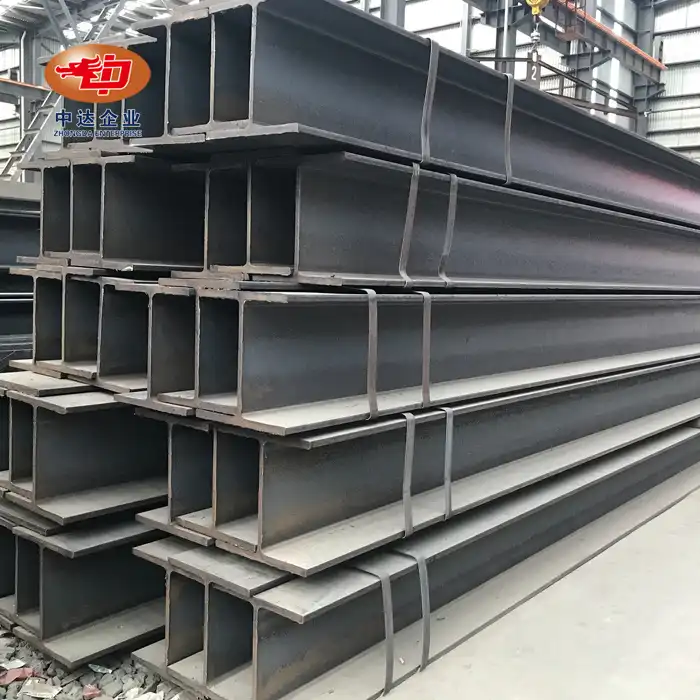
What Materials Are Used in Light Steel Villas and How Is Durability Ensured?
Light steel villas utilize advanced materials and innovative construction techniques to create durable, energy-efficient homes. The primary materials include cold-formed thin-walled steel (Q235/Q345 galvanized steel) for the main structure, complemented by sandwich panels (EPS, rock wool) for walls. This combination achieves both lightweight design and high strength. Durability is ensured through galvanization (zinc layer ≥85μm), sandblasting (Sa2.5 grade), and epoxy zinc-rich primer treatment, providing rust resistance for up to 50 years. Additional protection comes from concrete cover layers (≥50mm) and waterproof breathable membranes, further isolating corrosive agents.
At Zhongda Steel, we leverage our expertise in precision steel solutions to deliver high-quality light steel villas. Our BIM-driven prefabrication and advanced anti-corrosion technology ensure longevity and structural integrity in diverse environments. Let's explore the materials and durability measures in more detail.
Core Materials in Light Steel Villa Construction
Cold-Formed Thin-Walled Steel: The Backbone of Light Steel Villas
Cold-formed thin-walled steel serves as the primary structural component in light steel villas. This material offers an excellent strength-to-weight ratio, making it ideal for creating robust yet lightweight frameworks. The Q235 and Q345 grades of galvanized steel commonly used provide optimal performance in terms of load-bearing capacity and corrosion resistance.
The cold-forming process enhances the steel's mechanical properties, resulting in higher yield strength and ultimate tensile strength compared to hot-rolled steel of the same thickness. This allows for thinner sections to be used without compromising structural integrity, leading to more efficient material usage and reduced overall weight of the building.

Sandwich Panels: Insulation and Structural Support
Sandwich panels play a crucial role in light steel villa construction, providing both insulation and additional structural support. These panels typically consist of two outer layers of steel or other durable materials with a core of insulating material such as expanded polystyrene (EPS) or rock wool.
EPS offers excellent thermal insulation properties, helping to maintain comfortable indoor temperatures while reducing energy consumption. Rock wool, on the other hand, provides superior fire resistance and sound insulation. The choice between these materials depends on specific project requirements and local building codes.
Innovative Fastening Systems
To ensure the structural integrity of light steel villas, innovative fastening systems are employed. These may include self-drilling screws, rivets, and specialized connectors designed for thin-walled steel applications. These fastening solutions not only provide secure connections but also contribute to the overall durability and longevity of the structure.
At Zhongda Steel, we utilize advanced fastening technologies that complement our high-precision steel components, ensuring seamless assembly and long-term structural stability.
Durability Enhancement Techniques in Light Steel Villas
Galvanization: The First Line of Defense
Galvanization is a critical process in ensuring the longevity of light steel villa structures. By applying a zinc coating with a thickness of 85 micrometers or more, the steel is protected from corrosion and environmental degradation. This zinc layer acts as a sacrificial anode, corroding preferentially to protect the underlying steel.
The galvanization process not only extends the lifespan of the steel components but also reduces maintenance requirements, making light steel villas a cost-effective and durable housing solution.
Surface Preparation and Priming
Before the application of protective coatings, the steel surfaces undergo rigorous preparation. Sandblasting to Sa2.5 grade removes all visible contaminants, providing an ideal surface for coating adhesion. Following this, an epoxy zinc-rich primer is applied, offering an additional layer of corrosion protection.
This combination of surface preparation and priming significantly enhances the steel's resistance to rust and other forms of degradation, contributing to a potential service life of up to 50 years for light steel villa structures.

Advanced Protective Layers
To further enhance durability, light steel villas incorporate additional protective measures. A concrete cover layer of at least 50mm thickness provides physical protection against mechanical damage and acts as a barrier against moisture ingress. Waterproof breathable membranes are also utilized to prevent water penetration while allowing vapor to escape, reducing the risk of condensation and associated issues.
These advanced protective layers work in synergy with the galvanized steel to create a multi-faceted defense against environmental factors, ensuring the long-term structural integrity of light steel villas.
Innovative Design Approaches for Enhanced Durability
BIM-Driven Prefabrication
Building Information Modeling (BIM) plays a crucial role in the design and construction of durable light steel villas. By utilizing BIM technology, engineers can identify potential weak points in the structure and optimize the design for maximum durability. This approach allows for precise material selection, accurate load calculations, and efficient assembly planning.
At Zhongda Steel, our BIM-driven prefabrication process ensures that each component is manufactured to exacting standards, minimizing on-site errors and enhancing overall build quality.
Climate-Specific Adaptations
Light steel villas can be tailored to withstand specific environmental challenges. For instance, in coastal areas prone to salt spray, additional protective coatings or more corrosion-resistant alloys may be employed. In regions with extreme temperature fluctuations, the design may incorporate expansion joints and flexible connections to accommodate thermal movement.
Our experience in delivering steel structures to diverse global locations, including Arctic bridges in Russia and industrial facilities in Vietnam, informs our approach to climate-specific adaptations in light steel villa design.
Integration of Smart Technologies
To further enhance durability and performance, modern light steel villas often integrate smart technologies. These may include sensors for monitoring structural health, automated climate control systems to optimize energy efficiency, and advanced fire detection and suppression systems.
By combining traditional durability measures with cutting-edge technology, light steel villas represent a forward-thinking approach to sustainable, long-lasting residential construction.
Conclusion
Light steel villas represent a pinnacle of modern construction technology, combining innovative materials with advanced durability techniques. The use of cold-formed thin-walled steel, sandwich panels, and state-of-the-art protective measures ensures these structures can withstand diverse environmental challenges while providing comfortable, energy-efficient living spaces. As the demand for sustainable, long-lasting housing solutions grows, light steel villas are poised to play an increasingly important role in the future of residential construction.
Contact Us
Are you interested in exploring the possibilities of prefabricated light steel villas for your next project? Zhongda Steel offers comprehensive solutions, from design to manufacturing and installation. Our expertise in precision steel fabrication, combined with our commitment to innovation and quality, makes us the ideal partner for your light steel villa needs. Contact us at Ava@zd-steels.com to discuss how we can bring your vision to life with durable, efficient, and customizable light steel structures.
References
Zhang, L., & Li, Y. (2020). Structural performance of cold-formed steel residential buildings. Journal of Constructional Steel Research, 168, 105999.
Wang, X., et al. (2019). Durability of light steel framing in residential construction: A review. Construction and Building Materials, 224, 751-762.
Chen, W., & Ye, J. (2021). Seismic performance of light-frame cold-formed steel residential structures. Thin-Walled Structures, 158, 107122.
Smith, R. E., & Rupnik, I. (2018). 5 in 5 Modular Growth Initiative: Prototype House Research. Journal of Architectural Engineering, 24(4), 04018034.
Lawson, R. M., et al. (2018). Modular construction using light steel framing: An architect's guide. The Steel Construction Institute, Ascot, UK.
Mertens, L., et al. (2021). Life cycle assessment of a Belgian single-family house: a case study of prefabricated timber frame and prefabricated light steel frame. Journal of Cleaner Production, 283, 124997.













